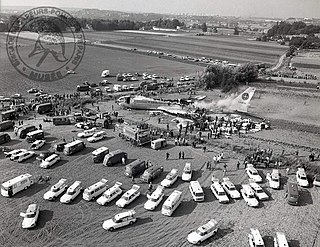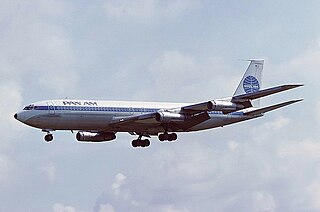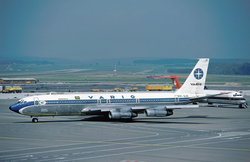
The Convair 990 Coronado was an American narrow-body four-engined jet airliner produced between 1961 and 1963 by the Convair division of American company General Dynamics. It was a stretched version of its earlier Convair 880 produced in response to a request from American Airlines: the 990 was lengthened by 10 ft (3.0 m), which increased the number of passengers from between 88 and 110 in the 880 to between 96 and 121. This was still fewer passengers than the contemporary Boeing 707 or Douglas DC-8, although the 990 was 25–35 mph (40–56 km/h) faster than either in cruise.
Viação Aérea São Paulo S/A, better known as VASP, was an airline with its head office in the VASP Building on the grounds of São Paulo–Congonhas Airport in São Paulo, Brazil. It had main bases at São Paulo's two major airports, São Paulo–Congonhas Airport (CGH) and São Paulo/Guarulhos International Airport (GRU).
TransBrasil was a Brazilian airline which ceased operations on 3 December 2001. During most of its history, Transbrasil was owned by local entrepreneur Omar Fontana. Its aircraft usually featured a colorful livery, remarkably with a rainbow on the tail fin. Transbrasil base was Brasilia International Airport in Brasilia. From the 1970s and until its demise in 2002, Transbrasil was usually the third largest Brazilian airline after Varig and VASP, serving both domestic and international routes.

São Paulo/Congonhas–Deputado Freitas Nobre AirportPortuguese pronunciation:[kõˈɡõɲɐs] is one of the four commercial airports serving São Paulo, Brazil. The airport is named after the neighborhood where it is located, called Vila Congonhas, property of the descendants of Lucas Antônio Monteiro de Barros (1767–1851), Viscount of Congonhas do Campo, first president of the province of São Paulo after the independence of Brazil in 1822, during the Empire. In turn, the Viscount's domain was named after the plural of a shrub known in Brazil as congonha-do-campo. Since June 19, 2017, it is officially named after Deputy José Freitas Nobre. The name Congonhas, however, remains mostly used. It is owned by the City of São Paulo.

Kenya Airways Flight 431 was an international scheduled Abidjan–Lagos–Nairobi passenger service, operated by Kenyan national airline Kenya Airways. On 30 January 2000, the Airbus A310-300 serving the flight crashed into the sea off the Ivory Coast, shortly after takeoff from Félix-Houphouët-Boigny International Airport, Abidjan. There were 179 people on board, of whom 169 were passengers. Only ten people survived.

Varig Flight 254 was a Boeing 737-241, c/n 21006/398, registration PP-VMK, on a scheduled passenger flight from São Paulo, Brazil, to Belém, capital city of the state of Pará in the country's North Region, on 3 September 1989. The flight had several intermediate stopovers, the last being in Marabá, Pará. Prior to takeoff from Marabá, the crew entered an incorrect heading into the flight computer, flying deep into a remote area of the Amazon jungle. Attempts to reach an alternative airport were unsuccessful and the plane eventually ran out of fuel, crashing during a belly landing in the jungle 1,700 kilometres northwest of Rio de Janeiro. Of the 54 passengers and crew, 12 passengers died and many more sustained serious injuries. The survivors were rescued two days later.

Varig Flight 820 was a flight of the Brazilian airline Varig that departed from Galeão International Airport in Rio de Janeiro, Brazil, on 11 July 1973, for Orly Airport, in Paris, France. The plane, a Boeing 707, registration PP-VJZ, made an emergency landing in onion fields about five kilometres from Orly Airport, due to smoke in the cabin from a fire in a lavatory. The fire caused 123 deaths; there were only 11 survivors . Relief Captain Antonio Fuzimoto was the pilot who handled the controls and landed the plane in the field.

Thai Airways Flight 365 was a Thai Airways Company Boeing 737-2P5 with the registration number HS-TBC. On 31 August 1987, the plane crashed during a scheduled flight from Hat Yai International Airport to Phuket International Airport, killing all 83 people on board: 74 passengers and 9 crew. It was the deadliest aviation accident in Thailand at the time, before being surpassed four years later by the crash of Lauda Air Flight 004. Concerned by another aircraft in their vicinity, the crew reduced their approach speed while attempting to land, and failed to recover from an aerodynamic stall. In addition to pilot error, the air traffic controller was blamed for failing to keep Flight 365 and the other aircraft adequately separated.

Pan Am Flight 816 was an international flight from Auckland, New Zealand, to San Francisco, California, via Tahiti, French Polynesia, and Los Angeles, California. It was operated by a Pan Am Boeing 707-321B bearing the registration N417PA and named Clipper Winged Racer. On July 22, 1973, at 10:06 P.M. local time, the Boeing 707 took off from Faa'a International Airport in Papeete. Thirty seconds after takeoff, the airliner, carrying 79 passengers and crew, crashed into the sea. All occupants except 1 passenger were killed.

Serviços Aéreos Cruzeiro do Sul was the second oldest airline of Brazil, tracing its origins to 1927, when it was founded as Syndicato Condor, a subsidiary of Deutsche Luft Hansa. Syndicato Condor retained rights and interests of a former German trade company, Condor Syndikat, which previously operated passenger and mail services in Brazil. It was renamed Serviços Aéreos Cruzeiro do Sul in 1943. In 1975, Varig, a Brazilian airline which shared very similar origins, acquired its controlling shares. In 1993, it was finally merged into Varig.

Félix-Houphouët-Boigny International Airport, also known as Port Bouët Airport, is located 16 km south east of Abidjan, Ivory Coast. It is the largest airport in the country for air traffic. The airport is the main hub of the national airline Air Côte d'Ivoire. Named after the first president of Ivory Coast, Félix Houphouët-Boigny, this international airport is directly connected currently to airports in Europe and to many destinations within the rest of Africa and the Middle East. The airport is served by 21 airlines, covering more than 30 destinations.
VARIG was the first airline founded in Brazil, in 1927. From 1965 until 1990, it was Brazil's leading airline and virtually its only international one. In 2005, Varig went into judicial restructuring, and in 2006 it was split into two companies – Flex Linhas Aéreas, informally known as "old" Varig, heir to the original airline – now defunct, and "new" Varig, a new company, fully integrated into Gol Airlines.

Varig Flight 967 was an international cargo flight from Narita International Airport in Japan to Rio de Janeiro–Galeão International Airport in Brazil, with a stopover at Los Angeles International Airport in the United States. On 30 January 1979, the Boeing 707-323C serving the flight disappeared while en route. Neither the aircraft nor its six crew members have ever been found.

Transbrasil Flight 303 was a flight from Congonhas-São Paulo Airport in São Paulo, Brazil, to Hercílio Luz International Airport in Florianópolis, Brazil, on 12 April 1980. It crashed on approach to Hercílio Luz International Airport. Only 3 of the 58 people on board survived.

Varig Flight 810 was a scheduled international passenger flight from Rio de Janeiro to Los Angeles with stopovers in Lima, Bogotá, Panama City, and Mexico City. On 27 November 1962 the Boeing 707-441 operating the route crashed into a mountain on approach to Lima, killing all 97 passengers and crew. At the time it was the deadliest aviation accident in Peru until being surpassed by LANSA Flight 502 in 1971 and later Faucett Perú Flight 251 in 1996.












